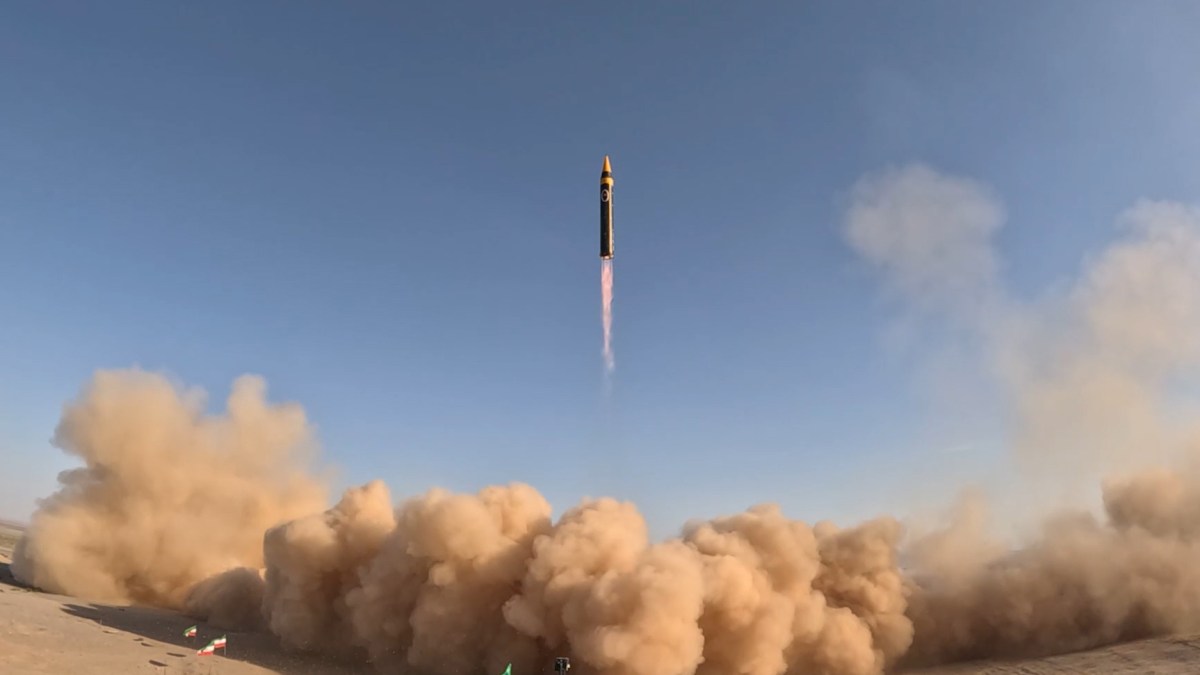On the 41st anniversary of the removal of Iraqi forces from the city of Khorramshahr (Mohammerah), Iran unveiled Khorramshahr ballistic missiles, choosing the name "Khyber Missile", stressing that it is equipped with a high-explosive warhead weighing 1500,<> kilograms, and that its high speed makes air defenses unable to intercept and destroy it.
The name of the missile symbolizes the Battle of Khaybar and the conquest of Jewish fortresses in the era of the Prophet, and Brigadier General Mohammad Mahdi Farhi, Iran's deputy defense minister, confirmed in press statements, "We named it Khaybar in the hope that this missile will be able to destroy enemy fortresses."
Date of manufacture
The Khyber Khorramshahr 4 is the latest generation of Khorramshahr long-range ballistic missiles, a surface-to-surface missile without ailerons, capable of carrying multiple warheads instead of one.
On September 22, 2017, the Iranian Ministry of Defense unveiled the first generation of Khorramshahr missiles, codenamed Khoramshahr-1, during the annual military parade marking Sacred Defense Week, an annual celebration that recalls the period of the Iran-Iraq War (1980-1988).
The Khoramshahr-1 missile is 13 meters long and 1.5 meters in diameter.
In 2019, Tehran unveiled the second type of these missiles under the name "Khoramshahr-2" in its ballistic arsenal, which is an upgraded version of the "Khoramshahr-1" missile, stressing that it is equipped with guided warheads, and weighs about 20 tons.
As part of the ongoing development of its missile system, the Iranian Ministry of Defense unveiled, on May 25, 2023, the fourth generation of Khoramshahr missiles, without unveiling the third generation so far.
A source close to the Iranian Ministry of Defense confirmed to Al Jazeera Net that the missile "Khorramshahr-3" has already been manufactured, but the policy of the Ministry of Defense is not to disclose its specifications due to its unique technical features.
What distinguishes the Khyber missile from previous models of Khorramshahr missiles is that the engine is placed in the fuel tank, which reduces its length to 13 meters, helps implement camouflage procedures that prevent its satellite detection, and uses artificial intelligence to carry out the necessary maneuvers to evade radar.
Specifications
The Iranian Ministry of Defense enumerated the specifications of the "Khyber" missile as follows:
- Range: Two thousand kilometers.
- Rocket length: 13 meters.
- Speed: Mach 16 outside the atmosphere and Mach 8 inside it (Mach 1 is approximately equal to 1224 km).
- Warhead weight: 1500 kg.
- Warhead length: 4 meters.
- Wing sold: no winglets.
- Time for preparing: less than 15 minutes.
- Launch pad: mobile.
- Engine: Homemade Arwand.
- Accuracy of injury: 30 meters based on a range of two thousand kilometers.
- Fuel storage period in the tank: 3 years and fuel can be kept up to 10 years.
- Fuel: Liquid
Tactical features
The triad of "the destructive ability of the warhead, its ability to bypass radar systems, and guide it from the moment of launch until the destruction of the target," highlighted the focus of the Iranian Defense Ministry's statement, which said that the Khyber missile is of the category of "point or precision-hit missiles", and does not need control and guidance in the stage before the attack on the target.
Iranian Defense Minister Brigadier General Mohammad Reza Ashtiani said in his speech on the occasion of the unveiling of the "Khyber" missile, that "one of the characteristics of this missile is to bypass radars and bypass enemy air defenses, and it can use a variety of warheads and carry the required warhead according to the mission entrusted to it."
Through Al Jazeera Net's monitoring of the statements of military officials in Iran, the tactical features of the missile are summarized as follows:
- It is the first Iranian guided missile in the second stage (outside the atmosphere), distinguished by its ease of preparation and launch and its high speed inside the atmosphere, which is Mach 8 before hitting the target, in addition to its enormous destructive capacity, and hitting the target accurately.
- The missile is fortified against cyber warfare, due to the switching off of guidance systems after entering the atmosphere, as it becomes a complete mechanical piece in the last stage, and does not emit an electrical or electronic pulse while entering the atmosphere.
- Equipped with the homemade Arvand engine, which is considered the "most advanced" among Iranian liquid-fueled engines, and the ability to control the missile outside the atmosphere and change its trajectory.
- The Khyber missile has a small cross-section, which radars cannot detect, and has no winglets, which reduces friction and increases the accuracy of hitting its targets.
The warhead of the missile is placed several kilometers outside the atmosphere (Getty Images)
Mechanism of action
In the first stage, the Khyber missile moves upwards after the launch, at a certain height and speed as planned, until the missile structure is separated from the warhead marking the launch of the second stage and adjusting the main range of the warhead, which completes its course towards the specified target.
An official agency quoted Brigadier General Mohammad Mehdi Farhi, Iran's deputy defense minister, as saying that "the warhead of the missile is placed at an altitude of several kilometers outside the atmosphere, and during this stage the engines behind this warhead carry out two operations: the first is to remove the turbulence caused by the separation of the original engine from the warhead, and the second is the use of other engines, which help the head to head towards the specified target."
"In the second stage, the warhead is ready to enter the dense atmosphere, so its speed gradually decreases, from Mach 16 to Mach 8 inside the atmosphere, and the third stage begins with the warhead entering the atmosphere, and the other engines are activated to be able to stop the deviation at a very high degree of rotation, and direct the missile towards the predetermined target," he said.

